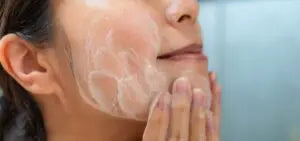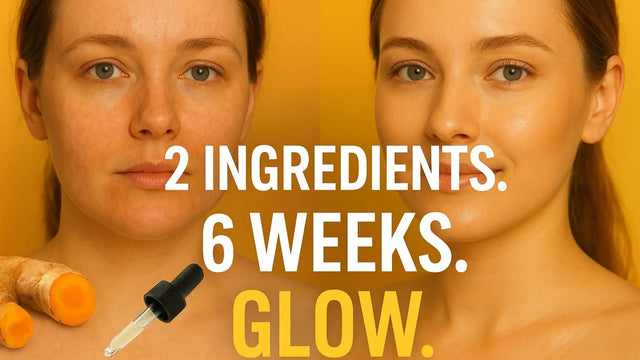Your skin maintains a precise chemical balance. When soap disrupts this balance, everything suffers. Dryness, irritation, breakouts, and premature aging all trace back to one invisible factor—pH.
Most people never consider their soap's pH. They wash daily with products that slowly damage their skin barrier. The tightness after cleansing isn't "squeaky clean." It's your acid mantle crying for help.
In this guide, you'll discover why pH matters more than ingredient lists. You'll learn how to choose soaps that protect rather than damage. Ready to transform your skin by mastering one simple concept? Let's explore pH.
⚗️ The pH Foundation
What pH actually measures: pH indicates how acidic or alkaline a substance is on a scale of 0-14. Pure water sits at neutral 7.0. Healthy skin maintains slightly acidic 4.5-5.5. Most traditional soaps clock in at alkaline 9-11. This massive pH difference disrupts your skin's protective barrier every single time you wash.
At AMVital, we formulate our turmeric soap to respect skin's natural pH. While true pH 5.5 soap requires synthetic detergents, our plant-based castile formula (pH ~8.9) falls between traditional harsh soaps and ideal levels—offering effective cleansing with better tolerability than high-pH alternatives.
Understanding Skin's Natural pH
Before choosing better products, you need to understand what your skin naturally maintains.
The Acid Mantle Explained
Your skin's protective barrier has a specific name and critical function.
What comprises the acid mantle:
- Sebum (natural oils): Fatty acids create slightly acidic environment
- Sweat: Lactic acid and amino acids lower pH
- Dead skin cells: Natural moisturizing factor contributes acidity
- Beneficial bacteria: Microbiome thrives in acidic conditions
Why acidity matters:
- Inhibits harmful bacteria growth (they prefer alkaline)
- Maintains skin barrier integrity and function
- Regulates enzyme activity for cell renewal
- Prevents excessive moisture loss
- Protects against environmental damage
🛡️ Your Invisible Shield
The acid mantle is your first line of defense. This thin, slightly acidic film covers your entire body surface. Think of it as an invisible force field that repels invaders while retaining moisture. When functioning optimally at pH 4.5-5.5, it creates an environment where beneficial bacteria flourish while harmful microbes struggle. Disrupt this pH, and the entire defense system falters. Protecting your acid mantle isn't optional—it's essential for healthy skin.
Optimal pH Range For Skin
Different skin areas and types maintain slightly different pH levels.
pH by body area:
- Face: 4.7-5.5 (more acidic, more delicate)
- Armpits: 6.0-6.5 (slightly higher, more moisture)
- Hands: 5.0-5.5 (frequently washed, needs protection)
- Feet: 5.5-6.5 (higher due to sweating)
- Genitals: 4.0-5.0 (most acidic, protects sensitive area)
pH by skin type:
- Oily skin: 4.0-5.0 (more acidic from sebum)
- Normal skin: 5.0-5.5 (optimal balance)
- Dry skin: 5.5-6.5 (less acidic, compromised barrier)
- Sensitive skin: Variable (often elevated due to damage)
What Disrupts Natural pH
Many daily factors push skin away from its optimal acidity.
Major pH disruptors:
- High-pH soaps: Most dramatic and frequent cause (pH 9-11)
- Hot water: Strips natural oils, raises pH temporarily
- Harsh cleansers: Sulfates and strong surfactants
- Environmental exposure: Chlorine in pools, hard water
- Over-washing: Prevents pH recovery between cleanses
- Alkaline skincare: Some products contain pH-disrupting ingredients
Signs of pH imbalance:
- Tightness or discomfort after washing
- Increased sensitivity and irritation
- Excessive dryness or oiliness
- Frequent breakouts
- Eczema or dermatitis flares
- Accelerated aging signs
How Traditional Soap Disrupts pH
Understanding why most soaps damage your skin helps you choose better alternatives.
The Saponification Process
Traditional soap-making creates inherently alkaline products.
How soap is made:
- Basic chemistry: Fats/oils react with lye (sodium hydroxide)
- The reaction: Saponification produces soap and glycerin
- Inevitable result: pH 9-11 due to soap molecule chemistry
- Cannot be changed: True soap must be alkaline by definition
Why soap must be alkaline:
- Soap molecules require alkaline environment to remain stable
- In acidic conditions, soap breaks down into oils again
- This is chemistry, not a formulation choice
- Even "natural" or "gentle" soaps face this limitation
📊 The pH Scale Reality
Understanding the gap:
- Healthy skin pH: 4.5-5.5 (slightly acidic)
- Pure water: 7.0 (neutral)
- Castile soap: ~8.9 (moderately alkaline)
- Traditional soap: 9.0-10.0 (alkaline)
- Strong soap bars: 10.0-11.0 (highly alkaline)
- Lye solution: 13-14 (extremely alkaline)
Each full point on the pH scale represents a 10x difference in acidity/alkalinity. A pH 9 soap is 10 times more alkaline than pH 8, and 100 times more alkaline than neutral water. That's why even small pH differences matter enormously to skin.
Immediate Effects On Skin Barrier
The moment alkaline soap touches skin, changes begin.
What happens during washing:
- pH spike: Skin surface jumps to 8-10 temporarily
- Barrier disruption: Lipid layers between cells separate
- Protein damage: Keratin structure destabilizes
- Moisture loss: Transepidermal water loss increases
- Microbial vulnerability: Protective bacteria struggle
Recovery timeline:
- Healthy skin: Returns to normal pH in 30 minutes to 2 hours
- Compromised barrier: Takes 4-6 hours or longer
- Damaged skin: May not fully recover before next wash
- Chronic use: Prevents complete recovery, causing cumulative damage
Long-Term Consequences
Daily use of high-pH soap compounds over time.
Chronic effects:
- Barrier breakdown: Progressive weakening of skin protection
- Microbiome disruption: Beneficial bacteria die, harmful ones thrive
- Increased sensitivity: Reactive to more products and environments
- Moisture impairment: Chronic dryness despite moisturizing
- Inflammation: Low-grade constant irritation
- Premature aging: Accelerated collagen breakdown
The vicious cycle:
- Alkaline soap damages barrier
- Damaged barrier recovers slowly
- Next wash happens before full recovery
- Damage accumulates over time
- Skin becomes increasingly compromised
⚠️ Warning Signs You're Using Wrong pH
Your skin is telling you:
- Tightness or "squeaky clean" feeling after washing
- Dryness returning within hours of moisturizing
- Increased breakouts despite regular cleansing
- Stinging when applying products
- Skin looks dull or aged
- Eczema or dermatitis worsening
- Need for heavier moisturizers than before
If you experience three or more of these signs, your soap's pH is likely too high. The solution? Switch to pH-balanced or lower-pH alternatives and watch your skin transform.
Why pH-Balanced Soaps Work Better
Products formulated closer to skin's natural pH provide dramatic benefits.
Minimal Barrier Disruption
Lower pH = less damage to your skin's protective systems.
How pH-balanced products differ:
- Gentler pH shift: Raises skin pH only to 6-7 vs 9-10
- Faster recovery: Skin returns to normal in minutes
- Less structural damage: Lipid layers stay intact
- Preserved proteins: Keratin maintains structure
Benefits of minimal disruption:
- Barrier remains effective between washes
- Moisture retention stays high
- Natural defenses stay active
- Microbiome thrives continuously
- Cumulative damage prevented
Better Moisture Retention
Intact acid mantle means hydrated, healthy-looking skin.
The moisture connection:
- Barrier integrity: Prevents transepidermal water loss
- Lipid preservation: Natural oils seal moisture in
- Protein function: Natural moisturizing factor works optimally
- Hydration efficiency: Moisturizers penetrate and perform better
Visible results:
- Plumper, more supple appearance
- Reduced fine lines and wrinkles
- Healthy glow instead of dull surface
- Makeup applies more smoothly
- Less need for heavy moisturizers
Reduced Sensitivity And Irritation
Balanced pH means calmer, more resilient skin.
Why sensitivity decreases:
- Intact barrier: External irritants can't penetrate easily
- Less inflammation: Reduced immune system activation
- Protected nerves: Sensory endings stay shielded
- Stable microbiome: Beneficial bacteria prevent inflammatory triggers
Who benefits most:
- Eczema and psoriasis sufferers
- Rosacea-prone individuals
- Those with contact dermatitis
- Sensitive skin types
- Anyone with reactive skin
Healthier Skin Microbiome
Your beneficial bacteria thrive in slightly acidic conditions.
Microbiome importance:
- First defense: Beneficial bacteria outcompete pathogens
- Anti-inflammatory: Produce compounds that calm skin
- Barrier support: Help maintain acid mantle
- Immune regulation: Train skin's immune responses
How pH affects microbiome:
- Alkaline pH kills beneficial bacteria
- Harmful bacteria thrive in alkaline conditions
- Repeated alkaline exposure prevents recovery
- pH-balanced products let good bacteria flourish
Types Of pH-Balanced Cleansers
Several formulation approaches achieve skin-friendly pH levels.
Synthetic Detergent Bars (Syndets)
Lab-created surfactants allow precise pH control.
How syndets work:
- Different chemistry: Not true soap, synthetic surfactants
- pH flexibility: Can be formulated to any pH level
- Common types: Sodium cocoyl isethionate, sodium lauryl sulfoacetate
- Bar or liquid: Works in both formats
Pros and cons:
- Pros: True pH 5.5 possible, excellent for sensitive skin, consistent performance
- Cons: Synthetic ingredients, may lack "natural" appeal, can be more expensive
pH-Adjusted Natural Soaps
Some natural formulations achieve better pH through specific techniques.
Approaches used:
- Superfatting: Extra oils lower pH slightly (still alkaline)
- Citric acid addition: Post-production pH adjustment
- Oil selection: Olive oil soaps gentler than coconut
- Emulsion-based: Not true soap, gentler surfactant systems
Realistic expectations:
- Rarely achieve true pH 5.5
- Can reach pH 7-8 (better than 9-11)
- Still gentler than traditional soap
- Good middle ground for natural preference
Gel And Cream Cleansers
Liquid formats offer more formulation flexibility.
Why liquids allow better pH:
- No need for bar structure stability
- Can use wider range of gentle surfactants
- Easy to add pH-adjusting ingredients
- More precise control possible
Best options:
- Gel cleansers: Light, foaming, good for oily skin
- Cream cleansers: Rich, non-foaming, ideal for dry skin
- Micellar waters: No-rinse option, very gentle
- Cleansing milks: Creamy, nourishing, low-foam
pH Labels Matter: Look for products specifically labeled "pH-balanced," "pH 5.5," or "dermatologist-tested for pH." Marketing terms like "gentle," "mild," or even "for sensitive skin" don't guarantee appropriate pH. If pH isn't mentioned on the label, it probably isn't optimized. When in doubt, contact the manufacturer to request pH information.
The Castile Soap Middle Ground
Natural castile soap occupies an interesting position in the pH spectrum.
Where Castile Fits
Castile soap is gentler than most traditional soaps but not pH-neutral.
Castile characteristics:
- pH level: Around 8.9-9.2 (moderately alkaline)
- Gentler than: Traditional soap bars (pH 9.5-11)
- More alkaline than: True pH-balanced products (pH 5.5)
- Plant-based: Typically olive or coconut oil derived
Why it's better tolerated:
- Simple ingredient list reduces irritation
- Natural oils provide some conditioning
- No harsh synthetic additives
- Traditional formulation, well-studied
When Castile Works Well
Certain skin types and situations suit castile soap.
Good candidates:
- Normal to oily skin: Tolerates higher pH better
- Body washing: Body skin less sensitive than face
- Natural preference: Want plant-based, minimal ingredients
- Budget-conscious: More affordable than syndets
- Quick recovery: Skin bounces back from pH shifts easily
How to use castile soap optimally:
- Follow immediately with pH-balancing toner
- Use on body, consider gentler option for face
- Don't over-wash (once daily maximum)
- Apply rich moisturizer while skin still damp
- Monitor for any sensitivity signs
AMVital's Turmeric Soap Approach
Enhanced castile formulation with skin-soothing benefits.
Why turmeric improves castile:
- Anti-inflammatory: Counters any pH-related irritation
- Antimicrobial: Maintains healthy microbiome despite pH
- Antioxidant: Protects skin during temporary barrier disruption
- Brightening: Provides additional skin benefits beyond cleansing
Best practices:
- Use for body where skin is more resilient
- Consider gel cleanser for facial use
- Always moisturize within 3 minutes of washing
- If any tightness occurs, switch to lower-pH option
🌟 The Turmeric Advantage
While AMVital's turmeric soap maintains traditional castile pH (~8.9), the addition of turmeric provides buffering benefits. Turmeric's anti-inflammatory properties help minimize any pH-related irritation. Its antimicrobial action supports skin microbiome even during temporary pH elevation. And antioxidants protect barrier integrity during recovery.
This means you get natural, plant-based cleansing with built-in damage control—a smart middle ground between harsh traditional soap and synthetic pH-balanced alternatives.
How To Choose The Right pH For You
Your ideal cleanser pH depends on several personal factors.
Consider Your Skin Type
Different skin types tolerate pH variation differently.
By skin type:
- Oily skin: Can tolerate pH 7-8, benefits from some oil removal
- Normal skin: pH 5.5-6.5 ideal, handles slight variation
- Dry skin: Needs pH 5.5 strictly, vulnerable to alkaline damage
- Sensitive skin: Requires pH 5.5, reacts strongly to imbalance
- Mature skin: pH 5.5 essential, barrier already compromised
- Acne-prone skin: pH 5.5 supports microbiome, prevents inflammation
Assess Your Current Barrier Health
Damaged barriers need stricter pH control.
Signs of healthy barrier:
- No tightness after cleansing
- Moisture lasts all day
- Products don't sting
- Minimal sensitivity to environment
- Even tone and texture
Signs of compromised barrier:
- Tightness within minutes of washing
- Chronic dryness despite moisturizing
- Products burn or sting
- Redness and irritation common
- Frequent breakouts or reactions
pH strategy by barrier status:
- Healthy barrier: Can use castile (pH ~8.9) or better
- Slightly compromised: Stick to pH 7-8 maximum
- Very damaged: pH 5.5-6.0 only until recovery
Match Format To Body Area
Different areas have different pH needs.
Area-specific recommendations:
- Face: Always use lowest pH option (pH 5.5 ideal)
- Body: Can tolerate slightly higher pH (7-8 acceptable)
- Hands: pH 5.5-6.5 (washed frequently, needs protection)
- Intimate areas: pH 4.0-5.0 specifically formulated products only
Product selection:
- Face cleanser: pH-balanced gel or cream
- Body wash: Enhanced castile soap or syndet bar
- Hand soap: Gentle liquid, pH 5.5-6.5
- Feminine wash: Specifically formulated, pH 4.0-5.0
Transitioning To pH-Balanced Products
Switching requires a brief adjustment period for best results.
What To Expect Initially
Your skin needs time to adjust to proper pH.
Immediate changes (1-3 days):
- Different feel: Less "squeaky clean" sensation
- Possible adjustment: Skin may seem oilier briefly
- Reduced tightness: No more uncomfortable pulling
- Gentler cleansing: May not foam as dramatically
Short-term improvements (1-2 weeks):
- Dryness decreases noticeably
- Irritation and redness fade
- Skin feels more comfortable
- Products absorb better
Long-term transformation (4-8 weeks):
- Barrier fully repairs
- Chronic sensitivity resolves
- Natural glow returns
- Moisture retention normalizes
- Aging signs may reduce
Adjusting Your Routine
Other products may need modification too.
Routine considerations:
- Moisturizer needs: May need lighter formulas as barrier improves
- Toner choice: pH-balancing toners less critical with balanced cleansers
- Frequency: May tolerate more frequent cleansing without damage
- Active ingredients: Better tolerated with healthy barrier
Supporting Barrier Recovery
Help your skin heal faster during transition.
Recovery support strategies:
- Gentle products only: Avoid harsh actives during transition
- Rich moisturizers: Support barrier repair with ceramides, fatty acids
- Minimal cleansing: Once daily maximum initially
- Lukewarm water: Hot water further damages recovering barrier
- Pat dry: Rubbing irritates compromised skin
Do's And Don'ts For Maintaining Optimal pH
Daily habits either support or sabotage your skin's pH balance.
✅ DO These
- Use pH-balanced cleansers: Check labels for pH 5.5 specification
- Apply moisturizer immediately: Within 3 minutes of cleansing
- Use lukewarm water: Hot water strips acid mantle
- Pat skin dry: Gentle treatment preserves barrier
- Layer products properly: pH-appropriate order matters
- Limit cleansing frequency: Twice daily maximum, once often sufficient
❌ DON'T Do These
- Use bar soap on face: Too alkaline for delicate facial skin
- Over-cleanse: Multiple daily washes prevent pH recovery
- Use hot water: Damages barrier and raises pH
- Scrub aggressively: Physical damage compounds pH disruption
- Skip moisturizer: Barrier needs support after cleansing
- Ignore product pH: All skincare products affect your skin's pH
Frequently Asked Questions
What is the ideal pH for skin?
Healthy skin has a slightly acidic pH between 4.5 and 5.5, with 5.5 being optimal for most people. This acidic environment is called the acid mantle—a protective barrier that fights bacteria, prevents moisture loss, and keeps skin healthy. When pH rises above 6.0, skin becomes vulnerable to dryness, irritation, infection, and accelerated aging. The acid mantle contains beneficial bacteria, natural oils, and dead skin cells that protect deeper layers. Maintaining this pH range ensures optimal barrier function, moisture retention, and natural defense against environmental damage.
How does soap affect skin pH?
Traditional soap is highly alkaline (pH 9-11), which disrupts skin's natural pH 4.5-5.5. When you wash with high-pH soap, it temporarily raises skin pH to 8-10. Healthy skin recovers in 30 minutes to 2 hours, but damaged or sensitive skin takes 4+ hours. During this vulnerable period, skin barrier weakens, moisture escapes, bacteria penetrate more easily, and irritation risk increases. Repeated daily washing with alkaline soap prevents full pH recovery, causing chronic barrier damage. pH-balanced soaps (closer to 5.5) cause minimal disruption, allowing skin to maintain its protective acid mantle continuously.
What are signs your soap's pH is too high?
High-pH soap causes recognizable skin problems: tightness or squeaky feeling after washing (stripped acid mantle), dryness and flaking within hours of cleansing, increased sensitivity and stinging from products, frequent breakouts despite cleansing, eczema or dermatitis flares, skin feeling rough or irritated, accelerated visible aging, and products not absorbing well. If you experience any of these symptoms, your soap's pH is likely too alkaline. Switching to pH-balanced alternatives typically resolves these issues within 1-2 weeks as skin barrier recovers and acid mantle normalizes.
Are natural soaps automatically pH-balanced?
No—natural doesn't mean pH-balanced. Traditional soap-making (saponification of oils with lye) creates alkaline soap regardless of natural ingredients used. Castile soap, while natural and gentle, still has pH around 8.9. True pH-balanced cleansers require specific formulation adjustments: using synthetic detergents (syndets) instead of traditional soap, adding pH-adjusting acids like citric acid, or creating emulsion-based cleansers. Some natural soaps are gentler than others (coconut oil soap is harsher than olive oil soap), but even the gentlest traditional soap remains more alkaline than skin's optimal pH. Look for products specifically labeled pH-balanced or pH 5.5, not just natural.
How long does it take skin to recover after using high-pH soap?
Recovery time varies by skin health and damage level. Single use recovery: healthy skin returns to normal pH in 30 minutes to 2 hours. Damaged/sensitive skin takes 4-6 hours or longer. Chronic damage recovery after switching to pH-balanced products: immediate improvement (1-3 days) includes less tightness and irritation. Barrier repair (1-2 weeks) brings moisture return and reduced sensitivity. Full recovery (4-8 weeks) restores optimal acid mantle function and normal resilience. The longer you've used alkaline soap, the longer full recovery takes. During transition, avoid harsh products and support barrier with gentle, pH-balanced skincare.
Your Skin Deserves Balanced Care
pH isn't a marketing buzzword. It's fundamental chemistry that determines whether your skincare helps or harms. Traditional high-pH soap damages your protective acid mantle daily, creating a cascade of skin problems.
The solution is straightforward—choose cleansers formulated closer to skin's natural pH 5.5. Whether you select synthetic pH-balanced products or gentler natural alternatives like turmeric-enhanced castile soap, lower pH means healthier skin.
Your skin wants to function optimally. It needs its acid mantle intact, its barrier strong, and its microbiome thriving. pH-appropriate products make this possible. Stop fighting your skin's chemistry and start supporting it.
The transformation begins with one simple change—respecting your skin's pH.
✨ Here's to your golden glow! ✨
Gentle Cleansing That Respects Your Skin
Experience the difference of better pH balance. Our turmeric-enhanced castile soap offers gentler cleansing than traditional soap, with anti-inflammatory benefits that support your skin barrier.
Shop Turmeric SoapTry Our pH-Friendly Gel Cleanser | Complete Collection
Questions? Contact us or email support@amvital.com







